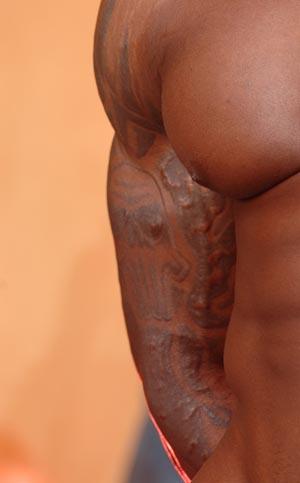
Africa scarification history shows that while scarring may seem like a new and avant garde form of body art, the practice is really quite ancient. Find out more about past scarification practices and how scarring fits into modern society.
About Africa Scarification History
For anyone who may not be familiar with scarification, it's an ancient African tribal body art that involves purposely scarring the skin to create raised marks and/or complete patterns.
It's generally believed that scarring was developed because the dark pigmented skin of the indigenous African people was not ideal for tattooing. By opening the skin, the uppermost layer of pigment was broken and filled in with slightly lighter shades of scar tissue. There was just enough contrast for the marks to show after the wounds had finally healed.
Scarification is still a ritualized practice in many African provinces, so let's take a look at some of the reasons for it and what scarring says about the person wearing it.
Reasons to Scar
Beauty
Scars are thought to beautify the body, and this journey for beauty through scarification often begins during childhood, especially for young African girls. The scarring takes place during rituals to celebrate the onset of puberty, the first menstrual cycle and childbirth.Although there are other reasons for the practice of scarification, the quest for beauty is nearly always part of the goal.

Strength and Courage
Scarification is also viewed as a test of courage. Scarring is quite painful, and requires great personal strength to get through the procedure without crying out in pain. To do so would be to humiliate yourself.
The amount of scarring on a person's body correlates directly with his/her perceived strength; the more scars a person has, the more respected he/she is within the community.
Fertility
Scarring is especially prized in young women of marriageable age. Abdominal scars are seen as an indication of a woman's willingness to bear children. According to African culture this is considered a very desirable quality in a future wife.The scars are also looked upon as erogenous, due to their tender nature. They're believed to make a woman more receptive to her husband's sexual attentions.
Family Pride
Scarring can also be a matter of family pride. One coming of age ceremony for a young man includes asking his sisters to endure a ritual beating that leaves their backs scarred and bloody. The scars are viewed as signs of love and respect from the sisters for their brother, and the girls endure the ritual without showing their pain. This brings honor to the entire family.
Protection from Death
Spirituality plays an important role in African culture, and many Africans believe in the presence of spirits around them, both good and evil. In a departure from using scarring as a way to beautify, facial scarring is sometimes used to make a person less desirable to the spirit of Death. In this case, scarring is used as a means of protection.
The Ancient Art of Scarring
According to Africa scarification history, scars were created in various ways, depending on their purpose. Some cuts were made with "Y" shaped blades, while others were created by pulling the skin up with fish hooks and slicing the flesh with a sharpened blade.
Once the wounds were inflicted, they were further inflamed by rubbing them with ashes and other substances to make them swell and leave a heavier scar. The process prolonged the healing time and left a more distinctive mark when all was said and done.
Modern Scarification

Reasons
Scarring may be an ancient art, but it is certainly not one that is fading away. Although scarification may be practiced slightly less than it used to be on the African continent, many Europeans and North and South Americans have adopted the practice.
Reasons for scarification today are much the same as they have always been:
- Scars are used to beautify the body with exotic patterns. In other words, they simply look cool when they're well done.
- Scarring is also used as a rite of passage and a test of inner strength. Once you've been through such an intense experience, everyday annoyances and fears seem mundane.
- Scarring can also be used to mark significant moments in your life. This could be the birth of a child, the death of a loved one or anything else that has a left a permanent mark on your consciousness or changed the course of your life.
Procedures
Modern scarification procedures are typically performed in a far more sterile environment than the ancients had available to them. Today, most scarring takes place in a well lighted body art shop, using sterilized surgical tools. Irritation of the wounds is usually encouraged by applying peroxide and/or petroleum jelly, and scabs are gently peeled away to prolong the healing process and create richer scars.
Is Scarring for You?
The choice to have yourself scarred is a very personal one, because no one can walk through the pain with you. The path is yours alone if you choose it.
Scarring is also permanent, so you should give the idea some deep thought before you make a decision to do it. Will the scars fit in with the rest of your life? Will your employer have a problem with your body art if it shows outside of your work clothes? Will your significant other find the scars as attractive as you do? These are all things to be considered as you weigh your decision.







